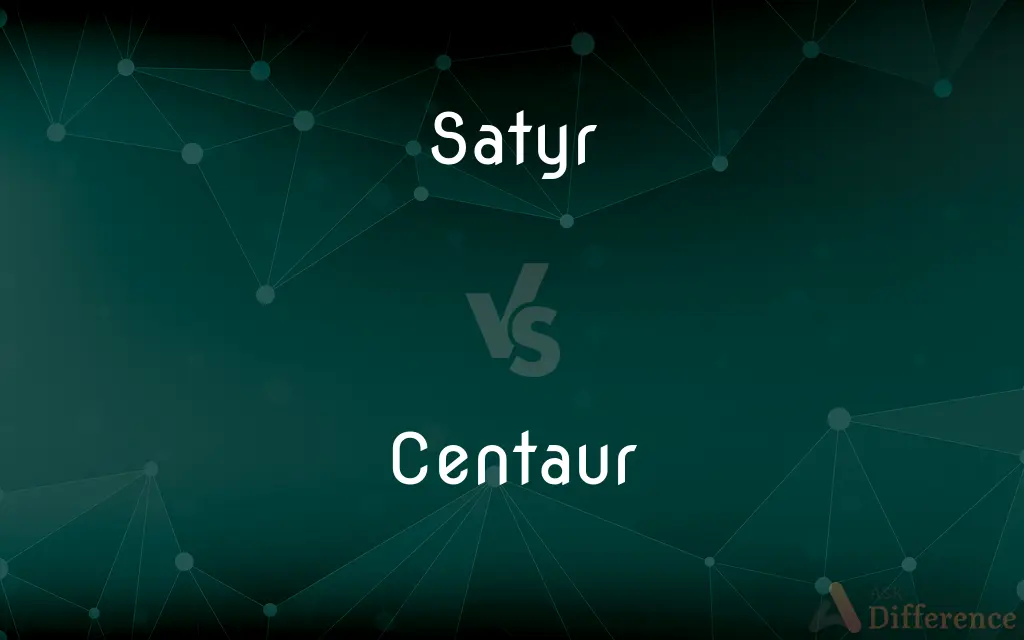Satyr vs. Centaur — What's the Difference?
Edited by Tayyaba Rehman — By Maham Liaqat — Updated on April 27, 2024
Satyrs are mythological creatures with human upper bodies and goat-like lower bodies, often associated with Dionysian revelry, whereas centaurs have human torsos attached to horse bodies, symbolizing a blend of civilization and wild nature.

Difference Between Satyr and Centaur
Table of Contents
ADVERTISEMENT
Key Differences
Satyrs are often depicted as male followers of Dionysus, embodying hedonism and chaos through their goat features and lustful behavior. In contrast, centaurs, creatures with the upper body of a human and the lower body of a horse, represent a duality of savage instinct and human intellect, often portrayed in myths as being caught between two natures.
While satyrs are typically shown in art and literature as playful and mischievous, fond of music, dancing, and wine, centaurs are depicted with a more complex narrative, sometimes as wise teachers, like Chiron, or as unruly beasts. This dichotomy in the portrayal of centaurs highlights a deeper philosophical exploration of humanity's primal instincts versus societal norms.
Satyrs are primarily associated with fertility and woodland deities, suggesting a symbolic connection to nature's untamed, reproductive force. Conversely, centaurs, despite their wild appearance, are occasionally linked to knowledge and mentorship, embodying a bridge between animalistic impulses and the pursuit of knowledge.
In terms of symbolism, satyrs represent excess and indulgence, often serving as a cautionary tale against overindulgence and moral degradation. Whereas centaurs, with their conflicted natures, can symbolize the internal struggle between civilized behavior and barbaric impulses, illustrating the constant human battle between mind and body.
Cultural representations of satyrs have evolved to depict them more benignly as creatures of jest and joy, a far cry from their original lascivious characteristics. In contrast, centaurs have maintained a consistent image in modern interpretations, often used to symbolize the struggle for balance, making them popular figures in fantasy literature and art.
ADVERTISEMENT
Comparison Chart
Origin
Greek mythology
Greek mythology
Body Structure
Upper body of a human, lower body of a goat
Human torso, horse's body
Symbolism
Excess, indulgence, fertility
Duality, nature vs. nurture, wisdom
Typical Behavior
Mischievous, lustful, playful
Dual-natured, ranging from wise to savage
Cultural Portrayal
Often comic and light-hearted
Often depicted as noble or chaotic, depending on the narrative
Compare with Definitions
Satyr
Often depicted as a follower of Dionysus, involved in wild parties.
Satyrs danced around the bonfire in the mythology-inspired performance.
Centaur
Represents physical power and intellectual depth.
The sculpture showed the centaur in a battle, a blend of strength and strategy.
Satyr
A creature from Greek mythology with a human upper body and goat-like lower body, known for lascivious behavior.
The ancient vase depicted a satyr playing a flute.
Centaur
Often portrayed as being torn between animalistic impulses and human intelligence.
The centaur struggled with his dual identity throughout the epic.
Satyr
A symbol of natural excess and unrestrained pleasure.
In the play, the character personified as a satyr, indulging in every delight.
Centaur
Symbolizes the conflict between the civilized world and wild nature.
In the mural, the centaur was depicted at the crossroads of a city and a forest.
Satyr
Represents the untamed aspect of nature and human psyche.
The novel's satyr character challenged the protagonist's conservative views.
Centaur
Can be seen as a figure of mentorship and wisdom in some myths.
The wise centaur taught the young heroes how to harness their strengths.
Satyr
A frequent participant in Dionysian rituals, embodying chaos and fertility.
The festival scene included several figures dressed as satyrs.
Centaur
A mythological creature with the body of a horse and the torso of a human.
The centaur in the story served as the guardian of the forest.
Satyr
In Greek mythology, a satyr (Greek: σάτυρος, translit. sátyros, pronounced [sátyros]), also known as a silenus or silenos (Greek: σειληνός seilēnós [seːlɛːnós]), is a male nature spirit with ears and a tail resembling those of a horse, as well as a permanent, exaggerated erection.
Centaur
A centaur (; Ancient Greek: κένταυρος, kéntauros, Latin: centaurus), or occasionally hippocentaur, is a creature from Greek mythology with the upper body of a human and the lower body and legs of a horse.Centaurs are thought of in many Greek myths as being as wild as untamed horses, and were said to have inhabited the region of Magnesia and Mount Pelion in Thessaly, the Foloi oak forest in Elis, and the Malean peninsula in southern Laconia. Centaurs are subsequently featured in Roman mythology, and were familiar figures in the medieval bestiary.
Satyr
Often Satyr Greek Mythology A woodland creature depicted as having the pointed ears, legs, and short horns of a goat and a fondness for unrestrained revelry.
Centaur
Greek Mythology One of a race of monsters having the head, arms, and trunk of a man and the body and legs of a horse.
Satyr
A licentious man; a lecher.
Centaur
(Astronomy) Any of a group of icy asteroids that orbit the sun primarily in the region between Jupiter and Neptune, whose orbits they cross. Some centaurs appear to be more like comets than asteroids.
Satyr
A man who is affected by satyriasis. No longer in clinical usage.
Centaur
(Greek mythology) A mythical beast having a horse's body with a man's head and torso in place of the head and neck of the horse.
Satyr
Any of various satyrid butterflies having brownish wings marked with eyespots.
Centaur
An icy planetoid that orbits the Sun between Jupiter and Neptune.
Satyr
(Greek mythology) A sylvan deity or demigod, male companion of Pan or Dionysus, represented as part man and part goat, and characterized by riotous merriment and lasciviousness, sometimes pictured with a perpetual erection.
Centaur
(chess) A chess-playing team comprising a human player and a computer who work together.
Satyr
(Roman mythology) faun
Centaur
A fabulous being, represented as half man and half horse.
Satyr
(by extension) A lecherous man.
Centaur
A constellation in the southern heavens between Hydra and the Southern Cross.
Satyr
Any of various butterflies of the nymphalid subfamily Satyrinae, having brown wings marked with eyelike spots; a meadow brown.
Centaur
(classical mythology) a mythical being that is half man and half horse
Satyr
(obsolete) The orangutan.
Centaur
A conspicuous constellation in the southern hemisphere near the Southern Cross
Satyr
A sylvan deity or demigod, represented as part man and part goat, and characterized by riotous merriment and lasciviousness.
Rough Satyrs danced; and Fauns, with cloven heel,From the glad sound would not be absent long.
Satyr
Any one of many species of butterflies belonging to the family Nymphalidæ. Their colors are commonly brown and gray, often with ocelli on the wings. Called also meadow browns.
Satyr
The orang-outang.
Satyr
One of a class of woodland deities; attendant on Bacchus; identified with Roman fauns
Common Curiosities
Who are some famous satyrs and centaurs in mythology?
Famous satyrs include Silenus, a wise and elderly companion of Dionysus. Notable centaurs include Chiron, who is known for his wisdom and mentorship, and Nessus, who is infamous for his role in the death of Heracles.
How are satyrs and centaurs typically involved in mythological stories?
Satyrs often appear in stories related to Dionysian festivities, acting as comic figures or instigators of chaos. Centaurs are usually involved in tales that highlight their dual nature, such as in battles or as teachers to Greek heroes.
Can satyrs and centaurs be found in modern media?
Yes, both creatures are popular in modern books, films, and video games, often reinterpreted to fit contemporary themes but generally retaining their mythological roots.
What is the typical setting associated with satyrs versus centaurs in mythology?
Satyrs are commonly associated with forests and natural landscapes, symbolizing wild, untamed nature. Centaurs are also linked to natural settings but often with a focus on their interaction with human civilizations, like the centaur Chiron who teaches in his cave.
What primarily distinguishes a satyr from a centaur?
A satyr has a human upper body and goat-like lower extremities, while a centaur has a human torso attached to a horse's body.
What symbolic meanings do satyrs and centaurs carry in literature and art?
Satyrs symbolize the human connection to nature, unrestrained pleasure, and fertility. Centaurs represent the conflict between rational thought and animal instinct, often serving as a metaphor for the human condition.
Are satyrs and centaurs typically depicted as good or evil in mythology?
Satyrs are generally depicted as mischievous but not evil, focusing on pleasure and revelry, whereas centaurs can range from noble and wise to violent and chaotic, depending on the story.
How do the abilities of satyrs compare to those of centaurs?
Satyrs are often depicted with abilities related to music and revelry, sometimes possessing magical powers to induce pleasure or fear. Centaurs are usually shown as strong and fast due to their horse bodies, with some like Chiron also skilled in healing and prophecy.
How do satyrs and centaurs interact with other mythological creatures?
Satyrs often interact with nymphs and other deities associated with nature and fertility, usually in supportive or antagonistic roles. Centaurs, given their dual nature, might interact with both beasts and human characters, illustrating their position between two worlds in mythological tales.
Are there any notable differences in how satyrs and centaurs are depicted in various cultures?
While primarily rooted in Greek mythology, both creatures appear in various forms in different cultures' folklore, adapting to local myths but generally retaining their half-human, half-animal natures.
How have the representations of satyrs and centaurs evolved over time?
Initially, both creatures were depicted with more fearsome and wild attributes in early art. Over time, satyrs have become more comical and playful, whereas centaurs have seen a broader interpretation, ranging from brutal to wise.
What festivals or traditions involve representations of satyrs and centaurs?
In ancient Greece, festivals like the Dionysia would often feature representations of satyrs as part of the festivities. Centaurs don't have specific festivals but are prominent in stories and artworks celebrated in various cultural artifacts.
Do satyrs and centaurs have any familial or clan structures in myths?
Myths typically depict satyrs as part of a loose group associated with Dionysus, lacking strict familial structures. Centaurs are sometimes shown as part of tribes or families, with some stories detailing lineage, such as that of Chiron, descended from the titan Cronus.
What are the typical adversaries or enemies of satyrs and centaurs in mythology?
Satyrs usually face opposition from those disapproving of their hedonistic lifestyle, such as more conservative gods or mortals. Centaurs often conflict with humans or other mythological creatures in battles or moral conflicts in stories.
Share Your Discovery

Previous Comparison
Furan vs. Oxole
Next Comparison
Accounting vs. AccountancyAuthor Spotlight
Written by
Maham LiaqatEdited by
Tayyaba RehmanTayyaba Rehman is a distinguished writer, currently serving as a primary contributor to askdifference.com. As a researcher in semantics and etymology, Tayyaba's passion for the complexity of languages and their distinctions has found a perfect home on the platform. Tayyaba delves into the intricacies of language, distinguishing between commonly confused words and phrases, thereby providing clarity for readers worldwide.














































